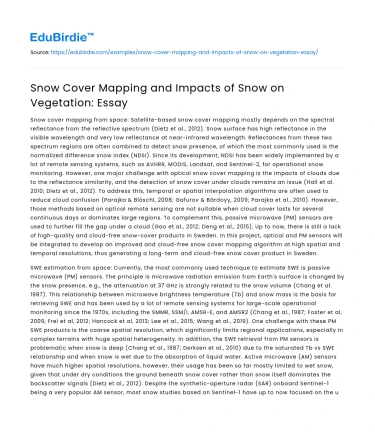Snow cover mapping from space: Satellite-based snow cover mapping mostly depends on the spectral reflectance from the reflective spectrum (Dietz et al., 2012). Snow surface has high reflectance in the visible wavelength and very low reflectance at near-infrared wavelength. Reflectances from these two spectrum regions are often combined to detect snow presence, of which the most commonly used is the normalized difference snow index (NDSI). Since its development, NDSI has been widely implemented by a lot of remote sensing systems, such as AVHRR, MODIS, Landsat, and Sentinel-2, for operational snow monitoring. However, one major challenge with optical snow cover mapping is the impacts of clouds due to the reflectance similarity, and the detection of snow cover under clouds remains an issue (Hall et al. 2010; Dietz et al., 2012). To address this, temporal or spatial interpolation algorithms are often used to reduce cloud confusion (Parajka & Blöschl, 2008; Gafurov & Bárdoyy, 2009; Parajka et al., 2010). However, those methods based on optical remote sensing are not suitable when cloud cover lasts for several continuous days or dominates large regions. To complement this, passive microwave (PM) sensors are used to further fill the gap under a cloud (Gao et al., 2012; Deng et al., 2015). Up to now, there is still a lack of high-quality and cloud-free snow-cover products in Sweden. In this project, optical and PM sensors will be integrated to develop an improved and cloud-free snow cover mapping algorithm at high spatial and temporal resolutions, thus generating a long-term and cloud-free snow cover product in Sweden.
SWE estimation from space: Currently, the most commonly used technique to estimate SWE is passive microwave (PM) sensors. The principle is microwave radiation emission from Earth's surface is changed by the snow presence, e.g., the attenuation at 37 GHz is strongly related to the snow volume (Chang et al. 1987). This relationship between microwave brightness temperature (Tb) and snow mass is the basis for retrieving SWE and has been used by a lot of remote sensing systems for large-scale operational monitoring since the 1970s, including the SMMR, SSM/I, AMSR-E, and AMSR2 (Chang et al., 1987; Foster et al, 2009, Frei et al, 2012; Hancock et al, 2013; Lee et al., 2015; Wang et al., 2019). One challenge with these PM SWE products is the coarse spatial resolution, which significantly limits regional applications, especially in complex terrains with huge spatial heterogeneity. In addition, the SWE retrieval from PM sensors is problematic when snow is deep (Chang et al., 1987; Derksen et al., 2010) due to the saturated Tb vs SWE relationship and when snow is wet due to the absorption of liquid water. Active microwave (AM) sensors have much higher spatial resolutions, however, their usage has been so far mostly limited to wet snow, given that under dry conditions the ground beneath snow cover rather than snow itself dominates the backscatter signals (Dietz et al., 2012). Despite the synthetic-aperture radar (SAR) onboard Sentinel-1 being a very popular AM sensor, most snow studies based on Sentinel-1 have up to now focused on the use of co-polarization instead of cross-polarization signals. The recent discovery of Sentinel-1 SAR cross-polarization backscatter for mapping dry snow SWE in global mountains has attracted wide attention from researchers (Lievens et al., 2019). However, the potential of AM sensors (e.g., Sentinel-1) for mapping the snow volume in Sweden is unclear and remains to be explored. In this project, I aim to integrate passive, active microwave, and optical sensors for developing an improved SWE estimation algorithm at the higher spatial and temporal resolution, and thus provide a more accurate estimation of snow volume at the national scale.
Save your time!
We can take care of your essay
- Proper editing and formatting
- Free revision, title page, and bibliography
- Flexible prices and money-back guarantee
Snow dynamics and impacts on vegetation: The changes in snowpack have important implications for vegetation growth (Buus-Hinkler et al., 2006; Johansson et al., 2013; Zeng & Jia, 2013). In high latitudes, the length of vegetation growth season is largely dominated by the snow cover. Changes in vegetation phenology associated with changing snow dynamics have been found in many regions (Johansson et al., 2013; Zeng & Jia, 2013) Therefore, to better understand climate change, it is key to investigate the response of vegetation to snow dynamics, especially in high latitude. Currently, there is no in-depth study on the relationship between snow and vegetation dynamics across Sweden. In this project, based on the newly developed snow products, both snow dynamics and the impacts of changing snow dynamics on different vegetation types in Sweden will be investigated.






 Stuck on your essay?
Stuck on your essay?

